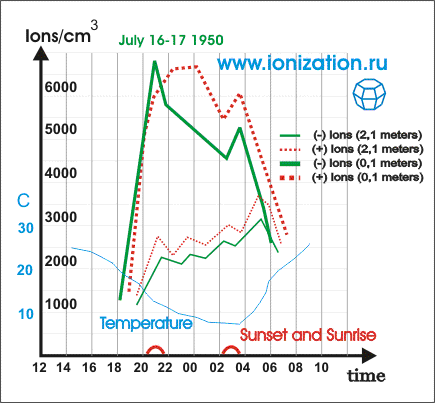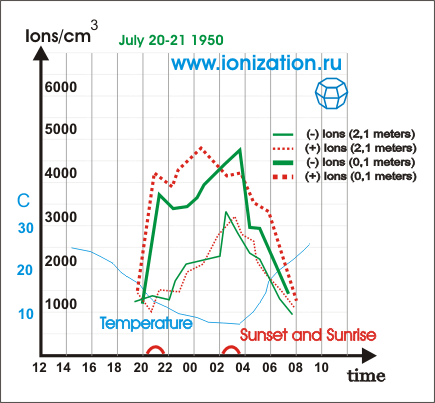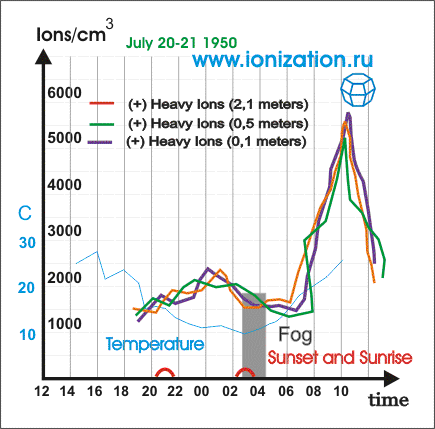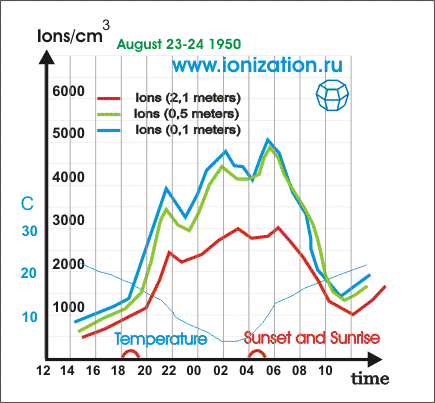Argument.
In this article there are represented results of big and small ions concentration measurements at different heights near the ground surface. The measurements are made in Uppsala during calm summer nights. To give the full picture of experiments there are also curves of ions concentration changes. Near the ground concentration of ions increases in comparison with higher layers of air. After the sunset the quantity of big ions lowers and reaches its minimal level before the sunrise. But after the sunrise their quantity increases very quickly. It is presented here that the concentration of big ions near the ground surface is a little bit lower than in higher layers of air. There is also a preparatory explanation of observed changes.
Introduction.
Previously we adduced the supposition that some changes of ions density, which we observed in summer of 1949, appeared because of the accumulation of radioactive substances evolved from soil and its decay products. To observe this process it was necessary to create special meteorological conditions in order to escape air mixture.
Measurements order.
There was developed the special device to gauge the density of ions on different levels above the earth. This device ingested the air on three levels h1=0,05-0,10m; h2=0,25-0,5m; h3=2,1m.
Results of measurements.
Measurement of ions density was carried out during the chosen nights when it was expected that weather conditions are favorable for accumulation of radioactive substances and there were no air transition near the ground surface. Nights, which were chosen for the experiment, were cloudless and calm. Changes of examined ion concentrations were indicated on picture 1. Dotted line showed the density of positive ions, firm line - the density of negative ions. Values of 0,1m level indicated in thick print. The temperature described on a picture we can take as the characteristic of meteorological conditions, which predominated during the experiment.




Подписи к рисункам можно увидеть при подводе курсора на них
Small ions
While studying pictures we could outline two kinds of ions concentration changes.
- slow changes, which developed during the whole period of observation.
- short-term changes that took the period of one or several hours.
There also could be changes with shorter period of development. Shorter changes could be observed as the result of weather conditions changes.
Increase of ions density on two upper levels (h=0,25m and h=2,1m) at 10PM on picture 4 was the example of such changes. Probably the reason of this increase was the migration of air with higher quantity of ions or local rise of radioactive ions from the ground surface and these ions produced other ions. After the increase of density on upper levels h2 and h3 there was observed its decrease on all levels. Similar effects were observed at night 2.40AM. Short-term variations of ions density could be explained as local disorders of general process, and study of these local variations would help to find out subtler changes of weather conditions, which would define the main regularity.
Form of curves of small ions concentration changes.
We can mention the following features of ions concentration changes:
- Near the ground surface is observed the increase of ions concentration and after the sunset this increase goes very fast. During the night the density of ions is quite high and just slightly decreases. In 1-2 hours after the sunrise this decrease goes very fast.
- In higher layers the decrease of ions density starts also from the sunset and continues about 2-3 hours after the sunrise. After that there is observed the sharp decrease of density.
- In higher layers of air the quantity of small ions is lower.
- It is important to mention the sharp decrease of negative ions concentration after sunset (picture 1), the concentration of negative ions predominates the concentration of positive ions at that moment. Similar effects were observed in other series of changes, especially in higher layers of air. (for example, picture 2).
- In addition to long period changes of ions density, changes that can be observed during the whole experiment, there are also short-time changes (during one or several hours).
- It seems the concentration of big ions near the surface is much higher than in higher layers of air. We can outline the decrease of concentration from the sunset up to the sunrise, when there is the minimal density of big ions. After the sunrise there is comparatively quick rise of curve.
The article was edited and expanded from Uppsala University Works
THE FULL OR PARTIAL CITATION OF THIS ARTICLE IS FORBIDDEN (write to info@ionization.ru)




